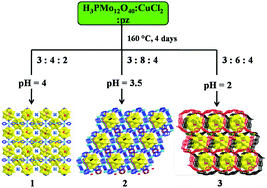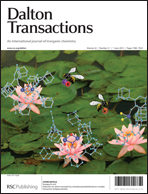Three new organic–inorganic hybrid compounds based on PMo12O40n− (n = 3 or 4) polyanions and CuI–pz/CuI–pz–Cl porous coordination polymers: [CuI(pz)]3[PMoVI12O40] (1), [CuI(pz)1.5]4[PMoVMoVI11O40]·pz·2H2O (2), [CuI3(pz)3Cl][CuI2(pz)3(H2O)][PMoVMoVI11O40] (3) (pz = pyrazine) have been hydrothermally prepared and characterized by elemental analysis, IR, TG, XRD, XPS and single-crystal X-ray diffraction. Compound 1 presents a three-dimensional CuI–pz framework with cube-like chambers, into which PMoVI12O403− Keggin ions are incorporated. Compound 2 shows a three-dimensional sandwich-like framework, and PMoVMoVI11O404− polyanions are located in the octagonal voids of every two-dimensional CuI–pz 4182 network structure. Compound 3 exhibits a two-dimensional Cl-bridged CuI–pz–Cl double-layer structure, and two kinds of PMoVMoVI11O404− polyanions as bridging linkers connect two adjacent double-layers to form a three-dimensional organic–inorganic framework through CuI–O bonds. Additionally, their electrochemical characters, electrocatalytic behaviors and solid state fluorescent properties at room temperature have been investigated in detail.

You have access to this article
 Please wait while we load your content...
Something went wrong. Try again?
Please wait while we load your content...
Something went wrong. Try again?


 Please wait while we load your content...
Please wait while we load your content...